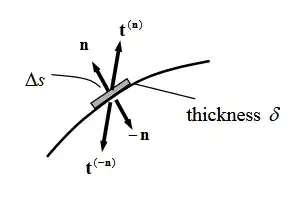For a small volume, with one of the vertex in a point $P = (x,y,z)$, the average forces acting on its faces can be splitted in 3 orthogonal components.
Let's take the axis $x$ and the faces normal to the axis at $P$.
The components at $x$ are:
$F_x(x) = \sigma_{xx}(x)\Delta y\Delta z$
$F_y(x) = \sigma_{xy}(x)\Delta y\Delta z$
$F_z(x) = \sigma_{xz}(x)\Delta y\Delta z$
The components at $(x+\Delta x, y, z)$ are:
$F_x(x+\Delta x) = \sigma_{xx}(x+\Delta x)\Delta y\Delta z$
$F_y(x+\Delta x) = \sigma_{xy}(x+\Delta x)\Delta y\Delta z$
$F_z(x+\Delta x) = \sigma_{xz}(x+\Delta x)\Delta y\Delta z$
For the faces normal to $y$-axis at $P$:
$F_x(y) = \sigma_{yx}(y)\Delta x\Delta z$
$F_y(y) = \sigma_{yy}(y)\Delta x\Delta z$
$F_z(y) = \sigma_{yz}(y)\Delta x\Delta z$
The components at $(x,y+\Delta y,z)$ are:
$F_x(y+\Delta y) = \sigma_{yx}(y+\Delta y)\Delta x\Delta z$
$F_y(y+\Delta y) = \sigma_{yy}(y+\Delta y)\Delta x\Delta z$
$F_z(y+\Delta y) = \sigma_{yz}(y+\Delta y)\Delta x\Delta z$
For the faces normal to $z$-axis at $P$
$F_x(z) = \sigma_{zx}(z)\Delta x\Delta y$
$F_y(z) = \sigma_{zy}(z)\Delta x\Delta y$
$F_z(z) = \sigma_{zz}(z)\Delta x\Delta y$
The components at $(x,y,z+\Delta z)$ are:
$F_x(z+\Delta z) = \sigma_{zx}(z+\Delta z)\Delta x\Delta y$
$F_y(z+\Delta z) = \sigma_{zy}(z+\Delta z)\Delta x\Delta y$
$F_z(z+\Delta z) = \sigma_{zz}(z+\Delta z)\Delta x\Delta y$
The small volume can be at rest but in a gravitational field, or can be accelerated. In any case, (or both) that effect can be represented by a body force per unit of volume $\mathbf b(x,y,z) = \mu \mathbf g - \mu \mathbf a$ acting at the center of gravity of the volume. After including the body forces, the sum of the forces in each direction must be zero. For example in $x$:
$\sigma_{xx}(x)\Delta y\Delta z + \sigma_{xx}(x+\Delta x)\Delta y\Delta z + \sigma_{yx}(y)\Delta x\Delta z + \sigma_{yx}(y+\Delta y)\Delta x\Delta z + \sigma_{zx}(z)\Delta x\Delta y + \sigma_{zx}(z+\Delta z)\Delta x\Delta y + b_x\Delta x\Delta y\Delta z = 0$
When $\Delta x -> 0$, while keeping $\Delta y\Delta z$ unchanged, only 2 terms remain:
$\sigma_{xx}(x)\Delta y\Delta z + \sigma_{xx}(x+\Delta x)\Delta y\Delta z = 0$
So it is valid that: $\sigma_{xx}(x) = -\sigma_{xx}(x+\Delta x)$ when $\Delta x -> 0$, what is the same as to say that the traction forces are equal and opposing at a surface.
Note that if we let $\Delta y -> 0$ or $\Delta z -> 0$ instead of $\Delta x$, we get the same result for the shear stresses.
The same procedure can be made for the components in $y$ and $z$ direction.
